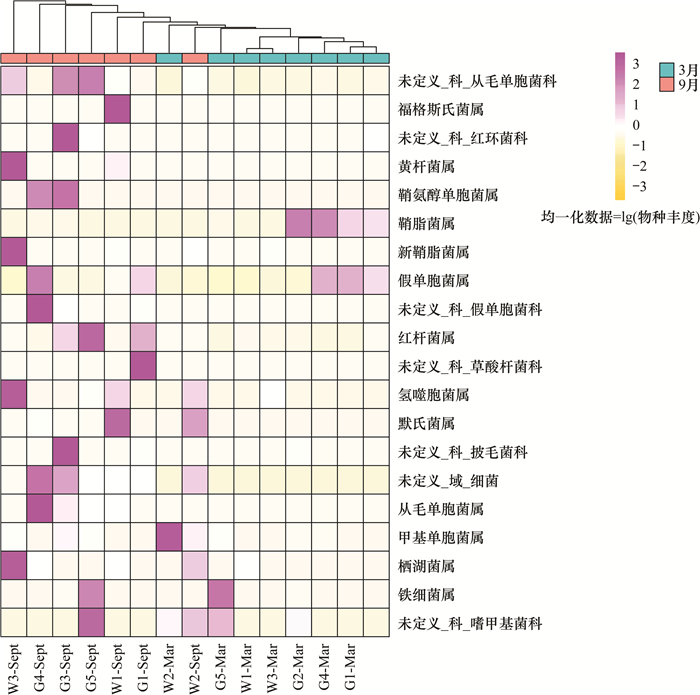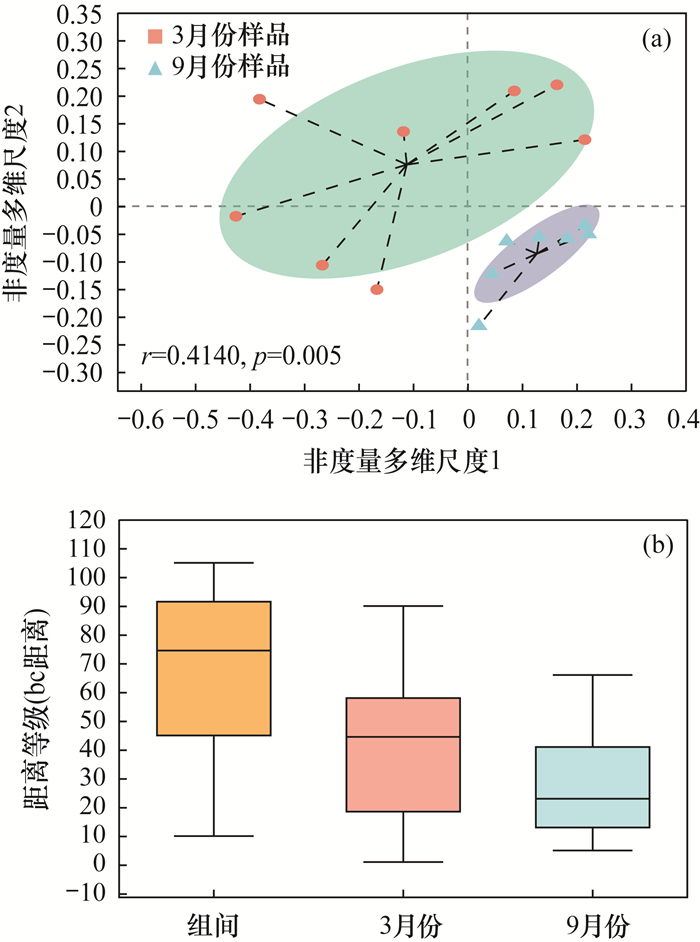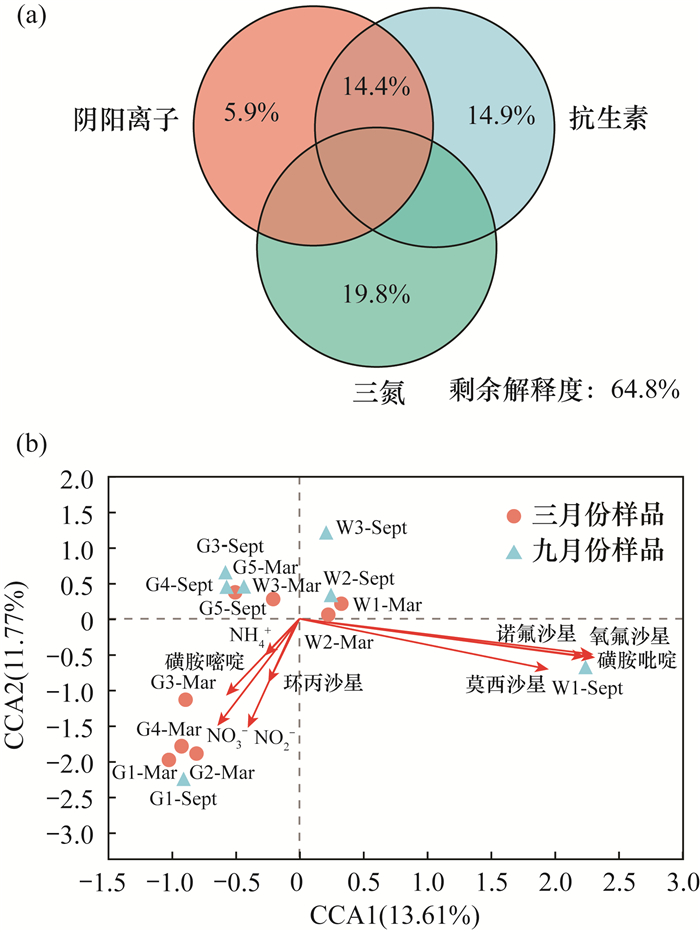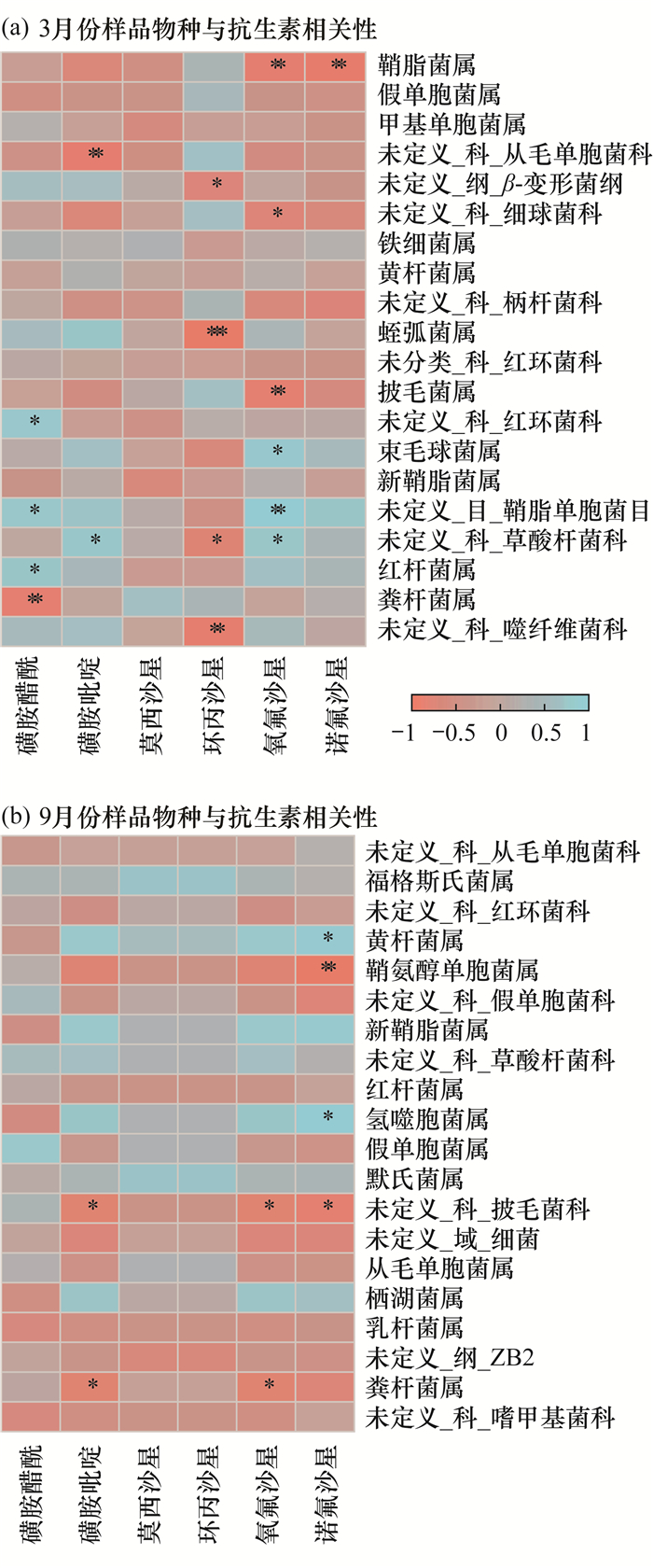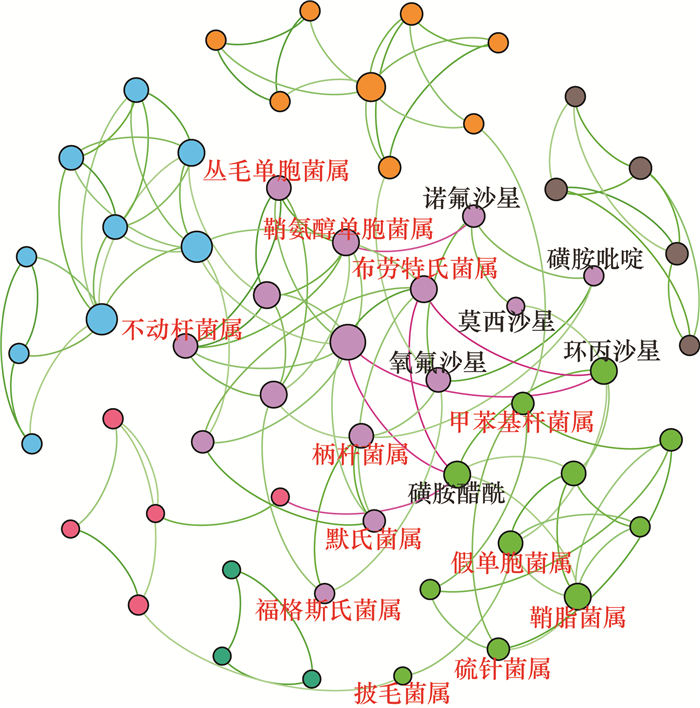Distribution Characteristics of Typical Antibiotics in Reclaimed Water Infiltration Area and Influencing Factors of Groundwater Microbial Community
-
摘要:
再生水入渗携带的抗生素污染是地下水污染的来源之一,已经成为城市地下水资源的安全中不可忽视的问题。抗生素对复杂和脆弱地下水环境中的微生物群落及其功能的影响值得关注。本研究基于利用16S rRNA基因高通量测序方法,对3月和9月两个月份再生水渗入区城市地下水中微生物群落结构进行分析。结合现场调查测试和室内分析,测得样品中离子(K+、Na+、Ca2+、Mg2+、NH4+、F-、Cl-、SO42-、NO3-、NO2-、HCO3-、CO32-)浓度,并采用超高效液相色谱-串联质谱技术测得主要的抗生素浓度(环丙沙星、诺氟沙星、氧氟沙星、莫西沙星、磺胺吡啶和磺胺醋酰),对研究区地下水环境中微生物群落结构及与环境因子的响应规律进行探讨。结果表明:①研究区内3月份地下水中抗生素浓度要高于9月份整体抗生素浓度,以磺胺醋酰和环丙沙星为主,此外除了季节因素外,人类活动可能是影响抗生素分布的又一因素;②微生物群落主要由变形菌门(Proteobacteria,81.04%),其次是拟杆菌门(Bacteroidota,7.60%)、厚壁菌门(Firmicutes,4.21%)等组成。三氮(NH4+、NO3-、NO2-、)和抗生素是影响研究区内微生物群落结构的重要影响因素,不同抗生素对微生物群落影响存在差异,其中磺胺吡啶、诺氟沙星、氧氟沙星和莫西沙星对微生物的影响最大,环丙沙星和磺胺醋酰的影响程度较小;③共现性网络分析发现有占据优势的两个功能群与抗生素有较高的连结度,即抗生素对该研究区内主要的微生物功能群及其功能存在潜在的影响。本研究可为认识抗生素对地下水微生物群落的影响机制以及生态风险提供帮助。
Abstract:BACKGROUND Antibiotic pollution carried by reclaimed water infiltration is one of the sources of groundwater pollution, which has become a problem that cannot be ignored in the safety of urban groundwater resources. The effects of antibiotics on microbial communities and their functions in complex and fragile groundwater environments deserve attention.
OBJECTIVES To explore the differences of groundwater environmental factors in different seasons and the distribution characteristics of antibiotic pollution, and to explore the influence mechanism of antibiotics on a microbial community.
METHODS Based on the high-throughput sequencing method of 16S rRNA gene, the microbial community structure in urban groundwater in the infiltration area of reclaimed water in March and September was studied. Combined with field investigation and indoor analysis, the ion (K+, Na+, Ca2+, Mg2+, NH4+, F-, Cl-, SO42-, NO3-, NO2-, HCO3-, CO32-) concentration in the sample was measured, and the main antibiotic (ciprofloxacin, norfloxacin, ofloxacin, moxifloxacin, sulfapyridine, sulfacetamide) concentration was measured by ultra-high performance liquid chromatography-tandem mass spectrometry.
RESULTS (1) In the study area, the concentration of antibiotics in groundwater in March was higher than that in September, mainly sulfacetamide and ciprofloxacin. In addition to seasonal factors, human activities may be another factor affecting the distribution of antibiotics. (2) The microbial community was mainly composed of Proteobacteria (81.04%), Bacteroidota (7.60%), and Firmicutes (4.21%). 3-nitrogen (NH4+, NO3-, NO2-) and antibiotics were important factors affecting the microbial community structure in the study area. Different antibiotics had different effects on the microbial community. Among them, sulfapyridine, norfloxacin, ofloxacin and moxifloxacin had the greatest impact on microorganisms, while ciprofloxacin and sulfacetamide had less impact. (3) Co-occurrence network analysis found that the two dominant functional groups had a high degree of connection with antibiotics, namely, antibiotics had a potential impact on the main microbial functional groups and their functions in the study area.
CONCLUSIONS The study provides support for understanding the impact mechanism of antibiotics on a groundwater microbial community and the ecological risk.
-

-
表 1 各采样点理化因子数据
Table 1. Physical and chemical factor data of each sampling point
样品编号 理化因子含量(mg/L) K+ Na+ Ca2+ Mg2+ NH4+ F- Cl- SO42- NO3- NO2- HCO3- CO32- W1-Mar - 12.44 72.52 48.14 0.63 0.34 179.00 108.00 23.30 0.19 - 216.98 W2-Mar - 13.58 127.35 81.93 1.26 0.42 165.00 71.90 7.52 0.16 - 330.06 W3-Mar - 12.62 99.49 61.64 0.07 0.60 76.40 63.00 9.48 0.02 - 255.49 G1-Mar 6.50 47.81 97.24 30.61 4.05 0.21 47.38 120.15 54.27 0.15 259.77 - G2-Mar 7.95 73.52 82.87 28.29 0.62 0.37 68.29 122.90 9.19 0.10 265.88 - G3-Mar 1.34 16.06 14.48 11.13 0.14 0.55 13.16 18.59 1.96 0.03 79.46 - G5-Mar 2.48 80.27 42.32 17.12 2.01 0.35 25.06 21.78 2.00 0.07 319.06 - W1-Sept 20.12 104.40 97.11 27.88 0.66 0.35 193.10 139.30 3.36 0.02 305.60 - W2-Sept 15.45 120.30 80.21 25.98 0.37 0.64 166.20 72.60 31.21 0.21 287.30 - W3-Sept 20.91 93.65 46.66 20.15 0.09 - 62.01 50.38 3.15 - 273.60 - G1-Sept 7.00 61.44 95.63 31.34 0.87 0.24 88.91 96.76 79.07 0.34 252.40 - G3-Sept 1.78 16.35 22.40 11.41 0.09 0.42 21.83 24.32 5.54 - 96.57 - G4-Sept 1.61 13.36 38.09 11.14 0.05 0.39 16.35 24.87 6.08 - 138.70 - G5-Sept 3.60 86.61 54.64 22.84 3.08 0.49 90.62 28.04 1.16 0.01 313.50 - 注:“-”表示低于检出限;G4-Mar未测试完整数据导致数据缺失未列出;G2-Sept由于采样点封闭,样品未采集,故缺失数据。 表 2 各采样点抗生素浓度
Table 2. Antibiotic concentration in each sampling point
样品编号 磺胺醋酰
(ng/L)磺胺吡啶
(ng/L)莫西沙星
(ng/L)环丙沙星
(ng/L)氧氟沙星
(ng/L)诺氟沙星
(ng/L)W1-Mar 267.50 47.03 21.43 30.57 438.33 111.17 W2-Mar 269.40 16.97 0.94 12.03 57.20 13.03 W3-Mar 196.53 11.67 9.45 36.30 106.33 19.77 G1-Mar 202.70 4.77 10.95 158.23 3.57 12.57 G2-Mar 209.20 3.73 0.95 31.97 3.04 1.36 G3-Mar 212.60 0.89 0.94 340.17 10.63 15.47 G4-Mar 196.97 0.83 0.99 37.27 3.23 1.77 G5-Mar 204.53 0.97 10.53 212.37 3.68 15.40 W1-Sept - 81.20 15.60 22.70 1210.00 100.00 W2-Sept - 9.70 - - 43.70 11.40 W3-Sept - 14.00 - - 144.00 12.80 G1-Sept - 7.97 - - 7.20 5.30 G3-Sept - 0.88 - - 3.05 - G4-Sept - 1.01 - - 3.19 1.14 G5-Sept - 1.22 - - 3.22 7.33 注:“-”表示低于检出限;G2-Sept由于采样点封闭,样品未采集,故缺失数据。 -
[1] 刘菲. 地下水污染监测与修复专栏成果简评[J]. 岩矿测试, 2012, 31(4): 645-646. doi: 10.3969/j.issn.0254-5357.2012.04.015 http://www.ykcs.ac.cn/article/id/ykcs_20120416
Liu F. Brief review on achievements of groundwater contamination monitoring and remediation[J]. Rock and Mineral Analysis, 2012, 31(4): 645-646. doi: 10.3969/j.issn.0254-5357.2012.04.015 http://www.ykcs.ac.cn/article/id/ykcs_20120416
[2] Biswas J K, Sarkar D. Nanopollution in the aquatic environment and ecotoxicity: Nonanoissue![J]. Current Pollution Reports, 2019, 5: 4-7. doi: 10.1007/s40726-019-0104-5
[3] Burri N M, Weatherl R, Moeck C, et al. A review of threats to groundwater quality in the anthropocene[J]. Science of the Total Environment, 2019, 684: 136-154. doi: 10.1016/j.scitotenv.2019.05.236
[4] Li J, Sun Y, Wang X, et al. Changes in microbial community structures under reclaimed water replenishment conditions[J]. International Journal Environment Research and Public Health, 2020, 17(4): 120-122.
[5] Sharma P, Pandey A K, Kim S H, et al. Critical review on microbial community during in-situ bioremediation of heavy metals from industrial wastewater[J]. Environmental Technology and Innovation, 2021, 24: 101826. doi: 10.1016/j.eti.2021.101826
[6] Fillinger L, Hug K, Griebler C. Selection imposed by local environmental conditions drives differences in microbial community composition across geographically distinct groundwater aquifers[J]. Federation of European Microbiological Societies Microbiology Ecology, 2019, 95(11): 45-48.
[7] Korbel K L, Greenfield P, Hose G C. Agricultural practices linked to shifts in groundwater microbial structure and denitrifying bacteria[J]. Science of the Total Environment, 2022, 807: 150870. doi: 10.1016/j.scitotenv.2021.150870
[8] Underwood J C, Harvey R W, Metge D W, et al. Effects of the antimicrobial sulfamethoxazole on groundwater bacterial enrichment[J]. Environmental Science and Technology, 2011, 45: 3096-3101. doi: 10.1021/es103605e
[9] 祁彦洁, 刘菲. 地下水中抗生素污染检测分析研究进展[J]. 岩矿测试, 2014, 33(1): 67-73. doi: 10.3969/j.issn.0254-5357.2014.01.012 http://www.ykcs.ac.cn/article/id/219a9a71-edb5-4da4-bf01-ee19b6961b6b
Qi Y J, Liu F. Analysis of antibiotics in groundwater: A review[J]. Rock and Mineral Analysis, 2014, 33(1): 67-73. doi: 10.3969/j.issn.0254-5357.2014.01.012 http://www.ykcs.ac.cn/article/id/219a9a71-edb5-4da4-bf01-ee19b6961b6b
[10] Wang Y F, Wang L F, Liu R M, et al. Source-specific risk apportionment and critical risk source identification of antibiotic resistance in Fenhe River Basin, China[J]. Chemosphere, 2022, 287: 131997. doi: 10.1016/j.chemosphere.2021.131997
[11] Lundstrom S V, Ostman M, Bengtsson-Palme J, et al. Minimal selective concentrations of tetracycline in complex aquatic bacterial biofilms[J]. Science of the Total Environment, 2016, 553: 587-595. doi: 10.1016/j.scitotenv.2016.02.103
[12] Flaherty C M, Dodson S I. Effects of pharmaceuticals on daphnia survival, growth, and reproduction[J]. Chemosphere, 2005, 61: 200-207. doi: 10.1016/j.chemosphere.2005.02.016
[13] Thuy T T, Huy B T. Highly stable Cs4PbBr6/CsPbBr3perovskite nanoparticles as a new fluorescence nanosensor for selective detection of trace tetracycline in food samples[J]. Journal of Industrial and Engineering Chemistry, 2021, 104: 437-444. doi: 10.1016/j.jiec.2021.08.046
[14] Hunter B, Walker I, Lassiter R, et al. Evaluation of private well contaminants in an underserved North Carolina community[J]. Science of the Total Environment, 2021, 789: 147823. doi: 10.1016/j.scitotenv.2021.147823
[15] Zhao J H, Li B, Huang X, et al. Distribution of antibiotic resistance genes and their association with bacteria and viruses in decentralized sewage treatment facilities[J]. Frontiers of Environmental Science and Engineering, 2022, 16(3): 35. doi: 10.1007/s11783-021-1469-4
[16] Zielinski W, Korzeniewska E, Harnisz M, et al. Wastewater treatment plants as a reservoir of integrase and antibiotic resistance genes—An epidemiological threat to workers and environment[J]. Environment International, 2021, 156: 106641. doi: 10.1016/j.envint.2021.106641
[17] Shigei M, Assayed A, Hazaymeh A, et al. Pharmaceutical and antibiotic pollutant levels in wastewater and the waters of the Zarqa River, Jordan[J]. Applied Sciences, 2021, 11(18): 8638. doi: 10.3390/app11188638
[18] Rajala K, Grönfors O, Hesampour M, et al. Removal of microplastics from secondary wastewater treatment plant effluent by coagulation/flocculation with iron, aluminum and polyamine-based chemicals[J]. Water Research, 2020, 183: 116045. doi: 10.1016/j.watres.2020.116045
[19] Sérodes J B, Behmel S, Simard S, et al. Tracking domestic wastewater and road de-icing salt in a municipal drinking water reservoir: Acesulfame and chloride as co-tracers[J]. Water Research, 2021, 203: 117493. doi: 10.1016/j.watres.2021.117493
[20] Caucci S, Karkman A, Cacace D, et al. Seasonality of antibiotic prescriptions for outpatients and resistance genes in sewers and wastewater treatment plant outflow[J]. Federation of European Microbiological Societies Microbiology Ecology, 2016, 92: fiw060. doi: 10.1093/femsec/fiw060
[21] Ding G, Chen G, Liu Y, et al. Occurrence and risk assessment of fluoroquinolone antibiotics in reclaimed water and receiving groundwater with different replenishment pathways[J]. Science of the Total Environment, 2020, 738: 139802. doi: 10.1016/j.scitotenv.2020.139802
[22] Jurado A, Margareto A, Pujades E, et al. Fate and risk assessment of sulfonamides and metabolites in urban groundwater[J]. Environment Pollution, 2020, 267: 115480. doi: 10.1016/j.envpol.2020.115480
[23] Vystavna Y, Schmidt S I, Diadin D, et al. Multi-tracing of recharge seasonality and contamination in groundwater: A tool for urban water resource management[J]. Water Research, 2019, 161: 413-422. doi: 10.1016/j.watres.2019.06.028
[24] Li W, Shi Y, Gao L, et al. Occurrence, distribution and potential affecting factors of antibiotics in sewage sludge of wastewater treatment plants in China[J]. Science of the Total Environment, 2013, 445-446: 306-313. doi: 10.1016/j.scitotenv.2012.12.050
[25] 马健生, 王卓, 张泽宇, 等. 哈尔滨市地下水中29种抗生素分布特征研究[J]. 岩矿测试, 2021, 40(6): 944-953. http://www.ykcs.ac.cn/article/doi/10.15898/j.cnki.11-2131/td.202101040001
Ma J S, Wang Z, Zhang Z Y, et al. Distribution characteristics of 29 antibiotics in groundwater in Harbin[J]. Rock and Mineral Analysis, 2021, 40(6): 944-953. http://www.ykcs.ac.cn/article/doi/10.15898/j.cnki.11-2131/td.202101040001
[26] Oliveira M A, Goulder R. The effects of sewage-treatment -works effluent on epilithic bacterial and algal communities of three streams in northern England[J]. Hydrobiologia, 2006, 568(1): 29-42. doi: 10.1007/s10750-006-0013-7
[27] Wang Z, Yuan S, Deng Z, et al. Evaluating responses of nitrification and denitrification to the co-selective pressure of divalent zinc and tetracycline based on resistance genes changes[J]. Bioresource Technology, 2020, 314: 123769. doi: 10.1016/j.biortech.2020.123769
[28] Fu J, Zhong C, Zhang P, et al. Novel nobilizable genomic island GEI-D18A mediates conjugational transfer of antibiotic resistance genes in the multidrug-resistant strain Rheinheimera sp. D18[J]. Frontiers in Microbiology, 2020, 11: 627. doi: 10.3389/fmicb.2020.00627
[29] Cairns J, Ruokolainen L, Hultman J, et al. Ecology determines how low antibiotic concentration impacts community composition and horizontal transfer of resistance genes[J]. Communications Biology, 2018, 1: 35. doi: 10.1038/s42003-018-0041-7
[30] Huang F, Zou S, Deng D, et al. Antibiotics in a typical karst river system in China: Spatiotemporal variation and environmental risks[J]. Science of the Total Environment, 2019, 650: 1348-1355. doi: 10.1016/j.scitotenv.2018.09.131
[31] Zhang Q, Zhang Z Y, Zhou S Y D, et al. Macleaya cordata extract, an antibiotic alternative, does not contribute to antibiotic resistance gene dissemination[J]. Journal of Hazardous Materials, 2021, 412: 125272. doi: 10.1016/j.jhazmat.2021.125272
[32] Gorodylova N, Michel C, Seron A, et al. Modified zeolite-supported biofilm in service of pesticide biodegradation[J]. Environmental Science Pollution Research, 2021, 28: 45296-45316. doi: 10.1007/s11356-021-13876-9
[33] Sperfeld M, Rauschenbach C, Diekert G, et al. Microbial community of a gasworks aquifer and identification of nitrate-reducing Azoarcus and Georgfuchsia as key players in BTEX degradation[J]. Water Research, 2018, 132: 146-157. doi: 10.1016/j.watres.2017.12.040
-



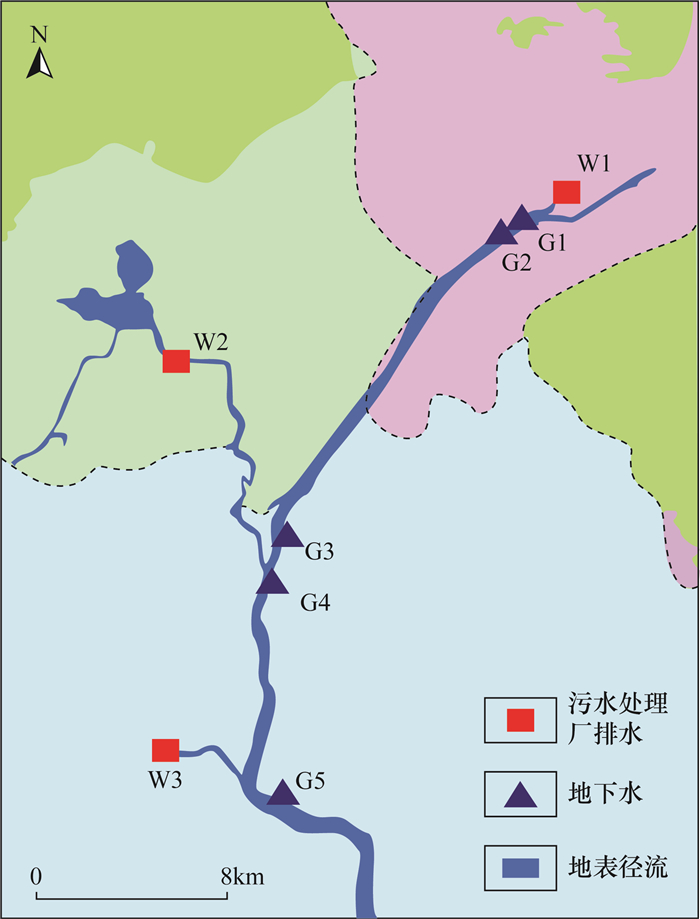
 下载:
下载:
